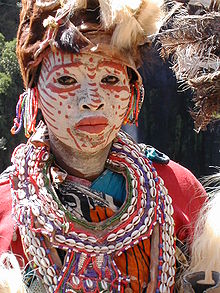User:Seagull123/sandbox
| This is not a Wikipedia article: It is an individual user's work-in-progress page, and may be incomplete and/or unreliable. |
This article is in the process of being translated from Famine de 1899 au Kenya central in the French-language Wikipedia. In order to reduce edit conflicts, please consider not editing it while translation is in progress. |
fr:Famine de 1899 au Kenya central

The Central Kenya famine of 1899 was a devastating catastrophe in the history of Kenya. It rapidly spread from 1898 in the central region of the country, around Mount Kenya, after several successive years of weak rainfall. An invasion of desert locusts, diseases in livestock which decimated herds, and the increasing need for food for British, Swahili, and Arab traders equally contributed to a decrease in food resources. Along with the famine, a smallpox epidemic occurred, which depopulated entire regions.
The exact number of victims is not known, but estimates by several European observers vary between 50% and 90% of the population. Everyone living in the affected regions were touched by the famine, to varying degrees.
As the famine coincided with the establishment of British colonisation of the region, the inhabitants of Central Kenya did not consider it as the result of natural causes. Rather, they interpreted it as a sign of a universal crisis, pushing the equilibrium between God and society, and which manifested itself also through colonisation.
The famine led to a social restructuring of the region. It facilitated the installation of the British colonial power and European Catholic missionaries, it contributed to ethnicisation and provoked for decades collective trauma within the population.
Central Kenya at the end of the 19th century[edit]

Social organisation[edit]
From the end of the 19th century, Central Kenya was already a region with a high population density, due to its fertile soils, and especially, at high altitudes, a wet climate. Next to the territory around Lake Victoria, it was - with around a million inhabitants (according to imprecise estimates) - the most populous region of British East Africa.[1] On the uplands between Mount Kenya and the Ngong Hills, communities of the Kikuyu, Embu, Meru, Mbeere and the Okiek lived; while the region more to the east and at lower altitudes was a semi-arid scrubland, mainly inhabited by the Kamba. The Kikuyu, Okiek, and Maasai also lived to the south of the Ngong Hills, and west of the Aberdare Range. In the high fertile lands, basic foodstuffs relied mainly upon agriculture, while in the dry scrubland it mainly rested upon pastoral farming.
Quite differently from how it appeared on 20th-century maps, these groups didn't live in clearly delimited territories. Quite the reverse, they were closely culturally and socially mixed. Their languages - apart from Maasai, a Nilotic language - were Bantu languages, and as a result closely related.[2] Apart from language, nothing in particular linked the speakers of the same language: they were not under the same political authority, and in general didn't follow the same common rituals. An ethnic identity, as it is now thought of, wasn't noted. Membership of the Maasai, for example, could change by moving home or by a change of the food economy, such as the transition from pastoral farming to arable farming.
People lived much more in small communities, in clans, in associations of families or villages. Such groups could even form between people of different linguistic origins. Often, these groups originated around an influential patriarch, who knew how to attract people to him by offering them the protection of the community. Most of the time, these communities were identified by the region where they lived, their founder, their common - or supposed - ancestors, or by their way of life as crop farmers, hunter-gatherers, or livestock farmers.
Regional exchange and contacts[edit]

However, these small communities stayed in close contact, even across language barriers. They often married between groups, traded with each other, and influenced each other in their ways of life, especially in the areas where they lived as neighbours. This contact was necessary for survival. The rich uplands served as a breadbasket for the whole region. If particular regions were threatened with famine due to drought, the inhabitants would go to the uplands to trade goats, sheep, cattle, poison arrows, tobacco, tools, weapons, metal, salt, medicinal herbs, honey, or even their labour-power for food such as millet, yam, beans, maize, or bananas.
- ^ Ambler 1988, p. 5
- ^ Ambler 1988, p. 4


